100 Monsters, Along With Ghosts, Spook Warfare, The Great Yokai War
Directed by: Kimiyoshi Yasuda, Takashi Miike, Yoshiyuki Kuroda
Written by: Mitsuhiko Sawamura, Takashi Miike, Takehiko Itakura, Tetsurô Yoshida
Starring: Akane Kawasaki, Chikara Hashimoto, Hiroyuki Miyasako, Jun Fujimaki, Kôjirô Hongô, Pepe Hozumi, Ryûnosuke Kamiki, Shinobu Araki
YOKAI MONSTERS COLLECTION: on Blu-ray 18th October, from ARROW VIDEO
And so a few months after their terrific release of the Daimajin trilogy [not to mention their incredible Gamera box set from some time before], Arrow Video’s contract with Japan’s Daiei Films – or rather Kadokawa Films who own Daiei – enables them to release another monster trilogy from the ’60s, one so obscure that I hadn’t even heard of it, though I’d certainly heard of the Takashi Miike reboot from 2005 which [yes!!] is also in this set. I was extremely keen to see these films that feature normal sized as opposed to giant creatures but which seem if anything even more strange and interesting…..
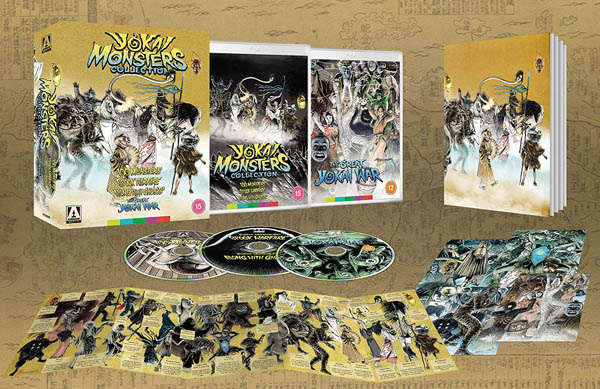
DISC ONE
100 MONSTERS [1968] AKA YOKAI HYAKU MONOGATARI
RUNNING TIME: 80 mins
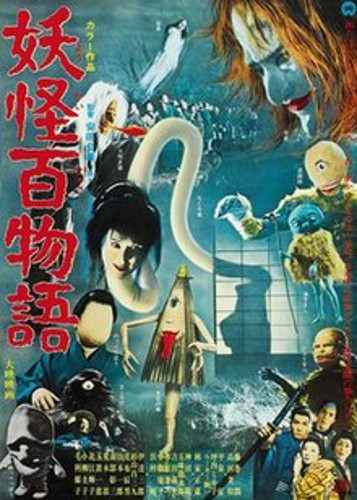
In a village in Edo, a group of men harass caretaker Gokei, claiming that he has to vacate his premises because they are allowed to take over and destroy the local shrine before building a brothel in its place. The men are in the service of unscrupulous magistrate Reimon Tajimaya, who himself is in the service of greedy landowner Hotta-Buzennokami who also wants to tear down the neighbouring tenement so he can build a brothel. To rally more support for this heinous plan, Tajiyama decides to host a Hyakumonogatari Kaidankai, a ceremony involving the telling of scary stories about yokai, but chooses to skip the purification ceremony that’s supposed to bring the evening to its end and ward off any evil spirits that may have been conjured up by the tales. Instead, he just bribes his guests with expensive tokens, telling them that they give protection from any spirits that might still be lurking around. Takimaya’s actions become crueler, but strange things start happening to his men….

I guess I should briefly begin this review by describing exactly what yokai are. Not at all an invention of these films, they are genuine beings of Japanese folklore, though the term can be expanded to include the likes of – I’m not joking – Pokemon. The word ‘yokai‘ is composed of the kanji [Chinese typographical characters uses in Japanese writing] for “attractive; calamity” and “apparition; mystery; suspicious.” Also referred to as ayaki, mononoke or mamono, they aren’t literally demons in the western sense of the word, but are instead spirits and entities who represent the unknown, and whose behaviour can range from malevolent or mischievous to friendly or helpful to humans. And they come in all sorts of shapes and sizes. Plenty of them can be seen in 100 Monsters, though the title isn’t strictly true; I’d say there were only about fifty or sixty of the creatures when seen altogether in the final reel, but this is still a decent number and should excite monster lovers; I had a ball. In fact I liked the proceeding seventy minutes too, even though the story is basically a variation of the plot of the three Daimajin films, with the same screenwriter Tetsuro Yoshida and director Kimiyoshi Yasuda. Well, I shouldn’t complain about plot recycling as a fan of the Godzilla series where many entries had basically the same plot, and the premise does work again, even on a smaller scale. Again, we see suffering and evil being done and almost pray for comeupence for the villains. And, unlike the giant statue pictures, it does show monsters in action right from the start, and, while using them sparingly until about two thirds of the way through, does remember to have the odd one or two show up to remind us of their presence, and boy are they weird!
A pan down from the moon to one of those typical artificial but aesthetically appealing Japanese forest sets shows us a man walking. Lost and hearing animal sounds, he’s scared by some rustling in bushes and a big eye which also scared us a little. The eye belongs to a hairy ape-like thing that chases after the man whom a wind prevents from getting away; the thing grabs the man, and we can immediately tell that we’re seeing a motionless dummy with mechanical arms but it doesn’t matter; we’re in the land of the fantastique and aren’t bothered by the obvious artificiality. It’s revealed that we’ve been watching a story told by one person to others, and are now at a Hyakumonogatari Kaidankai ceremony, where a hundred stories of the supernatural are told and after each one, one of the hundred candles lighting the room is put out, until all of the lights are gone. After this, a small purification ceremony is performed, as a narrator tells us, to make sure that the spirits mentioned in the stories will not come back to haunt the participants. While not directly linked to the main plot, this is a perfect opening that immediately gets you into the right atmosphere; not so much scary [okay, it is a little bit] as just weird or unsettling, though it’s possible of course that I’m saying this as a westerner; a Japanese person watching this at the same time may very well have a totally different response. And then come the opening titles, the slow pan along a lengthy painting of yokai which also appears in the film proper later set to tremendously eerie music combining percussion, theramin, jew’s harp and laughter. It sounds like Akira Ifukube in his more experimental mode, but actually it’s by Humei Watanabe.
The sinister tone bleeds into the next scene where kids playing are told by the caretaker Gokei not to knock over all the umbrellas he has positioned. We know it’s some kind of ceremonial thing but aren’t told any details of this, but it’s enough to make us feel both angry and worried when some bad guys come along and knock them all about. The head of this tenement seems to be Jimbei, and it’s his daughter Okiku who witnesses the harassment and then beating of Gokei. She goes to a house where the only young man about because the others are off working, Yasutaro, has to be woken up and then claims that there’s nothing he can do, though we get a sense that we should keep an eye on him. Jimbie says that he also can’t prevent Tajiyama from going ahead with this awful plan, because Tajiyama seduced him into a scheme where he got behind on payments for a medicine for his ill wife and had to put up the tenement as collateral. Gokei is then found murdered while Tajiyama organises his own Hyakumonogatari Kaidankai ceremony for Hotta but arrogantly ignores the most important part; the finish, where everyone present has to be made safe. And, while we only hear one full story and small parts of two others, all of these stories seem to feature yokai of the menacing kind in morality stories which probably doesn’t help the status quo out there. Of course we know where things are going, but the pacing is quite good, just gradually excellarating and increasing the part that the yokai play, while extra intrigue is added by Yasutaro, who does eventually help though we’re not exactly sure who he is or what his motivations are. All he says it that he’s a masterless samurai. Though a couple of moments involving him that seem that they’re going to lead into full-on samurai action conclude in disappointment, he does bring some money intended to stop Okiku being taken away to be the bride of Hotta, and later carries out a rescue.
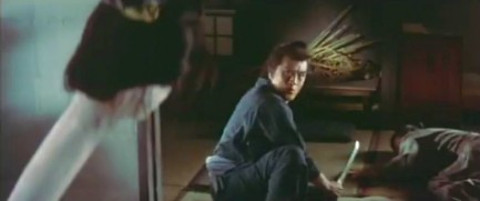
Hotta and Tajiyama will do anything to achieve their ambitions, but we know that they’ll get their just deserts. However, the yokai, some of whom seem able to shapechange into humans, usually – though not always – scare or confuse their victims into killing each other or themselves rather than actually slaying them. Indeed we’re a little confused ourselves about them, but isn’t that refreshing? The most frightening scene for most will be when we have somebody relating the story of two fishermen who continued to fish in an area an old man warned them not to several times. They return to one of the fisherman’s houses where his wife starts to cook their catch. However, she then spouts a very long neck and attacks them. Excellent editing and fairly sparing use of actual special effect shots – the full growing is seen in silhouette while close-ups of the face have the actress’s head and just the top of the neck underneath – give the scene a real impact and must have really wowed viewers at the time. Soon after that we encounter somebody painting pictures of some kind of cross between a human and an umbrella. The person is Shinichi, the mentally challenged son of Tajiyama. Suddenly one of the drawings starts doing funny poses and dances, and of course Shinichi isn’t frightened, just transfixed. Then by the love of god an actual living breathing umbrella man appears to hop about and lick Shinichi’s face with his very long tongue. The yokai is obviously a puppet, but the thing looks just so bizarre, and don’t puppets have their own particular qualities? I found it genuinely unnerving, others may chuckle, but you won’t have seen a creation like that for a long time. Faceless people and a giant face that appears everywhere are later highlights.
When the things appear all together, among all the people and puppets are quite a few strange apparitions that I wanted to see get closer too, see more of, and if you’re a monster lover than you probably will do. It looks like Yasuda had to cope with quite a low budget here more like he got on his many Zatoichi entries, compared to Daimajin which, like its two sequels, was a pretty lavish productions with the very best special effects work that could be done at the time, east or west. But it doesn’t really hamper the film; for example the giant back projected face looks almost as convincing as that amazing work done when Daimjin went on his rampages. Yasuda keeps the pace going even though the odd scene – like one particular murder and the finding of the body – doesn’t have the power it was clearly intended to, while cinematographer Yasukazu Takemura gives us a few nice uses of shadow, like darkness falling across one half of a character’s face, eveb though there clearly wasn’t much time for this sort of thing. Onscreen violence is very minimal; one gets the impression that this film was intended as a family affair, maybe more than than the Daimajins. Acting is solid, though Watanabe’s score only occasionally moves away from his opening music, usually just repeating the same phrases at different speeds. But it works and that’s what’s important. Maybe it’s partly because I’m not Japanese [though I’ve seen plenty of Japanese films including most of the acknowledged classics], but I was quite bewitched through parts of 100 Monsters, which mixes gritty drama, folklore and mild fear in an edifying way. The second to last scene is one of the most magical visions I’ve seen in some time. All the yokai walk, dance and jump as they make their way out of the village, into the countryside and into their own dimension; we feel like we’re in the wonderful, wonderful world of Spirited Away for a moment or two, and you can’t get much better than that.
Rating: 









SPECIAL FEATURES
Original uncompressed Japanese mono audio
Hiding in Plain Sight, a brand new documentary giving a primer on yokai for Western audiences, featuring interviews with experts Matt Alt, Zack Davisson, Kim Newman, Lynda E. Rucker and Hiroko Yoda [41 mins]
Just in case there were spoilers for the films following this one, I opted not to watch this until all of them had been viewed. There turned out not to be any spoilers, but the clips may be too frequent and long for some; yet for some it might be useful for some to watch it before the films since it tells us about yokai. Even though I’d already read up a bit about them on Wikipedia, I found it absolutely fascinating. We learn that these beings were airbrushed out when the modern Japan appeared, with belief in them made to be a mental illness. However, a writer named Shigeru Mizuki was told many of the yokai stories by elderly folk, and featured some in his manga. Their huge popularity saw a revival that led to, as well as many other things, the Teenage Mutant Ninja Turtles. Kim Newman has a rokurokubi toy while we learn about a few specific yokai including Anabia, a plague-spreading yokai who became popular when the covid pandemic came along. A great piece that’s only flawed for me by being too short; I’d have sat through another half hour of this.
US re-release trailer
Image gallery
DISC TWO
SPOOK WARFARE [1968] AKA YOKAI DAISENSO
RUNNING TIME: 79 mins
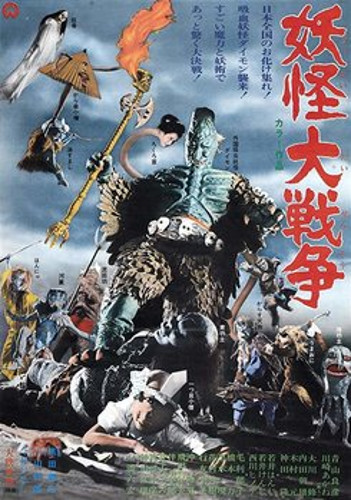
In the ruins of the Babylonian city of Ur, two graverobbers accidentally release a powerful demon named Daimon who flies to Japan and kills Lord Hyogo Isobe before drinking his blood and assuming his form. He tears down all the altars in his house and orders his servants to have them burned. In his frenzy, he throws out an ornament which falls into a pond outside, rousing a kappa [water yokai] who investigates and sees Daimon [as Isobe] drinking the blood of Isobe’s steward, Saheiji Kawano, who then becomes also becomes a vampire. The kappa attacks Daimon but is defeated and goes to the woods to seek out other yokai to help him in the fight, but none of them believe him. However, as the vampirism spreads, they may just have to do something….
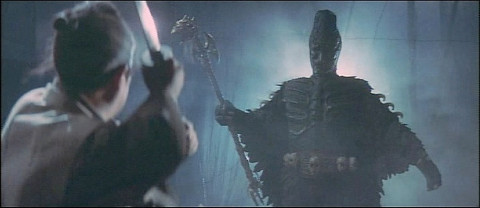
As I commence writing the main part of my review f0r the second film in this set, I’ve only just realised that I’m breaking a rule I set myself around a year ago; if I’m reviewing a set that contains more than three films, then the writeup of each film would be quire short, both to save me work and to make the articles more presentable. But I’ve just broken my rule in my review for the first film without thinking about it. Oh well, I’m finding these films to be so interesting so it’s not as if I’m struggling to find things to say; far from it. I had a feeling that Spook Warfare would follow the same Daimajin-style template that 100 Monsters did, but it seems that the filmmakers or the producers realised that this could become tedious, as well as realising something else; that while the human side of things in 100 Monsters did compel, people were most interested in the monsters. So they decided to place the monsters more centre stage than the humans, and have another monster as the main opponent. This one consequently has a very different feel, one that’s far more manic. Comparing it with the original does raise questions as to what’s best; a monster movie that slowly builds up to its monsters or one that shows them from the very outset. Being generally a patient sort, I tend to prefer the former and never have a problem with waiting, but I’m nonetheless glad that Spook Warfare is the way that it is. Continuingly filling the screen with all these bizarre and freaky beings creates an almost hallucinatory feel, which is something I always enjoy. If it were better known I wouldn’t be surprise it it would have garnered a reputation as being a good film to smoke weed or trip on LSD or magic mushrooms to. Me personally, I’m always scared of doing such things while watching a film like this which is trippy enough with just a cup of tea.
In a totally different opening to that of the first one, we pan across some desert, skeletons and signs of excavation while a narrator tells us of this demon who lays dormant in the rubble of this city. A legend about Daimon waking in four thousand years time kept people away for some time, but eventually the legend became forgotten and the treasure hunters began to appear. The title music by Kei Ikeno isn’t as interestingly arranged as the one we heard in 100 Monsters but it’s just as menacing. It’s also based on the repeated two-note figure that, speeded up, became the main part of the Jaws theme. Two men are digging at the foot of a hill, but a large black cloud darkens the sky, fog comes out of the top of the hill and Daimon is free, looking genuinely menacing. A landslide kills the two men and Daimon flies into the air, sinking a ship simply by passing over it causing the stormy waves to become even stormier, before encountering Lord Hyogo Isobe. Isobe tries to put up a good fight but is understandably no match for something that vanishes when you strike it and which is able to knock you over by not even touching you. Then, as if all this isn’t dark enough, Daimon in the form of Isobe, kills the family dog who barks at him when he comes home. We’ve really been watching a horror movie for the last ten minutes, and we may have expectations that the whole film will be like this. However, Daimon throws an ornament into a pond which strikes the head of a kappa -imagine a Teenage Mutant Ninja Turtle as drawn by Hayao Mijazaki. Seeing through Daimon’s facade immediately, the over-confident yokai challenges him to a fight, which soon becomes comedic as the kappa tries to ram Daimon twice and bumps off him and into a wall respectively, while Daimon rubs the kappa‘s bald head on a wooden post, almost starting a fire.
If you’re like me and get a kick out of this sort of thing then you’ll be in heaven, but it’s also safe to say that this is where you should check out if it’s too daft or weird for you, because it ain’t going to change. The kappa returns to the forest which is populated by all manners or beings including our two favourites from the previous film; the long neck woman who’s called [says Wikipedia, though we only learn a couple of names in the film] the rokurokubi, and that umbrella man actually named the kasa-obake. In a particularly funny moment, the yokai don’t believe the kappa‘s story, as they insist such a monster has never been found in Japan, citing and presenting two books as evidence; ‘The Apparitions Who’s Who’ and the ‘Japanese Apparition Field Guide’. But the vampirism is spreading among the humans. Shinpachiro Mayama, who’s friendly with Isone’s daughter Lady Chie, decides to consult his uncle, a priest who for some reason shouts every single one of his words. He gives Shinpachiro three candles to be placed around the room in which the demon is sitting while the priest chants destruction prayers in order to destroy the demon, but it all goes wrong. Daimon now wants younger blood and goes hunting for children. Two young kids escape while their family is being killed and don’t seem that bothered, but they run into the yokai and it’s enough to finally get them to step in., though only, it seems, because their “reputation as Japanese apparitions will be ruined”. The battle goes on forever, but never drags because there’s always different stuff going on, from Daimon tying Rokurokubi’s neck into a knot to Daimon trapping most of the yokai in a magic jar.
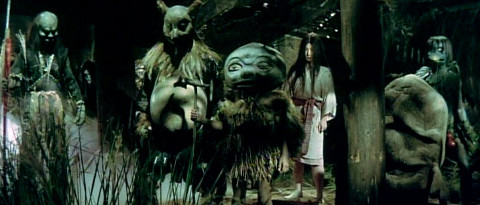
Wikipedia has load of information about the actual folkloric yokai in this movies, from their background to how faithful the film depictions are. The Rokurokubi, for example, is a cursed woman whose appearance is generally human, but whose curse causes disturbing distension of the neck. She’s generally described as being harmless, but frightful: often a vengeful spirit seeking revenge for a indiscretion. The film stays relatively true to this depiction of the Rokurokubi, keeping her a harmless character who uses her frightening neck-stretching as a humorous attack. I love this stuff but I really need to set it aside until I’ve completed this review at least, but the film tells you none of this. I guess Japanese viewers would be more familiar with it. The only really characterised yokai in the film is the kappa, who’s quite delightfully innocent. When he sees human children, he’s terrified and thinks they’re ghosts. The main yokai range from the futakuchi-onna who has another face with a very long nose on the back of her head, to the neppepp who’s a genderless mass of flesh with an outline of a face creased into the folds of its fatty exterior, to another one [name I couldn’t find out] whose huge stomach, when rubbed, produces a portal through which one can watch things that are happening else – so basically a TV then. While not really presented as proper characters, the portrayal of the yokai [except for the kappa] as creatures of good who are in some case toned down from their folkloric predecessors, yet who are also rather insular and most interested in their image, is an interesting one. I get the feeling that the budget was a big larger for this one, considering the far greater use of the yokai. The special effects aren’t any weaker; in fact the rokurokubi‘s neck’s looks even better. Yes, it’s obvious that we’re seeing people in suits or puppets, but that doesn’t matter, at least to us oldies to whom CGI is often just as obvious.
Overall the effects serve their purpose fine and the budget only seems to hamper things at the climax where we don’t quite get the sense of two warring armies. It will be interesting to see if The Great Yokai War, the final film in this set and a more recent endeavour from Takashi Miike that will probably use CGI, will contain yokai which have the charm of these. Much like The Wrath Of Daimajin but to an even greater degree, Spook Warfare seems for some of the time aimed at children, with the antics of the yokai often quite juvenile, yet is also pretty violent, with no less than three bloody eye violations; okay, they aren’t lingered on but I was still surprised. Most of the scenes with the somewhat Pazuzu-like Daimon have some real fear to them despite Daiei’s liking for showing the actual eyes of suit performers a la Daimajin. The human characters are okay as are the performers playing them but we barely remember them. Lingering in my mind far more are things like the lovely garden set, with its purple hues and its fog, the latter not coming across as sinister but quite otherwordly. There was obviously a bit more time for nice setups on this one, and Ikeno'[s score is more diverse than that of Watanabe’s work on 100 Monsters. The main course to 100 Monsters’s starter, Spook Warfare is often insanely entertaining and a cult favourite waiting to happen. It concludes in the same manner as the first film, yet takes the opportunity to improve it. As the yokai go home across a beautiful fog-covered morning set, they seem happy, yet we’re a little sad, because we loved these folk. We’re reminded of how we need monsters, folklore and just plain weirdness in our lives.
Rating: 









ALONG WITH GHOSTS [1969] AKA TOKAIDO OBAKE DOCHU
RUNNING TIME: 78 mins
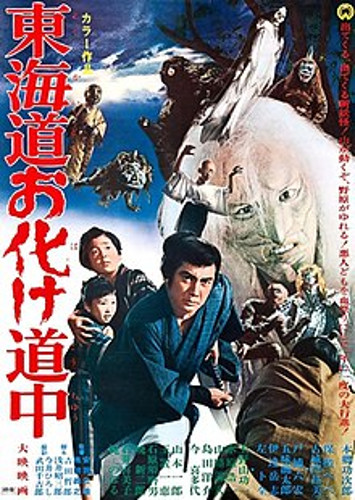
Right by a shrine, a gang of samurai led by Higuruma are about to ambush two others to reclaim the evidence that would incriminate them. Jimbei, the elderly guradian of the shrine, warns them to not spill any blood or a curse will fall upon them, because this is a special place called the Onizuki that’s connected to the spirit world. They go ahead anyway and fatally wound Jimbei, but the piece of paper they’re after flies away and comes into the possession of the shrinekeeper’s seven-year old daughter Miyo. At their house, the dying man gives Miyo some dice and instructs her to find her father Tohachi in the nearby city of Yiu. A hard task for a little girl, especially with Hituruma’s lot after her, but maybe another one of Higurama’s targets, Hyakotaro, can help….
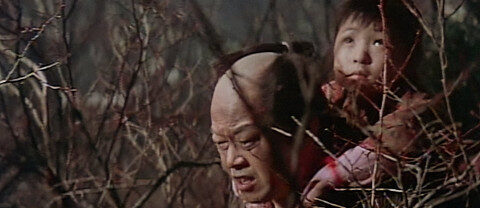
I’d imagine that some viewers may be disappointed in this final instalment in the trilogy, largely because our yokai really aren’t in it much at all. Maybe the producers realised that with the small budget they had it would be difficult to top Spook Warfare, so they opted not to try and instead go down a different route. The Daimajin-style premise of bad people being punished that was at the forefront of 100 Monsters is returned to, and we always like seeing that, but it’s a while before we see any yokai and even after that they only become a major feature in the final third. Fortunately though, the storyline isn’t bad and both characterisation and acting are superior to what we’ve seen previously, meaning that we’re engaged anyway. Indeed there’s a strong emotional core to the plot, involving a young girl reuniting with the father she’s never seen. It’s hard not to be touched by that, isn’t it, especially if the father is a bad egg whose daughter was taken away from him because he was a gambler and a criminal. In fact what bothered me more was how different the yokai are; they’re just ugly human ghosts, sometimes even shown as being see through. Some are quite deformed and spooky to look at, and they have some cool tricks at their disposal, but I really missed the truly unique monsters from before; but saying that, one has to always try to admire a film in a series that goes down a different route, even if it’s one that you may not like that much. And I did like the more grim tone, with no goofing around; even when the yokai play with their victims, it seems more serious. This means that horror fans who found the second film a bit too silly for their tastes may find this one more to their liking even though for some of the time it feels like we’re watching a typical samurai actioner.
A shot of the shrine where the plot begins opens the film over which we here wicked laughter, after which a nice pan along the forest set where around half the action will take place is seen behind the titles while the piece by composer Chumei Watanabe, returning from 100 Monsters, repeats his motif from that film but gives it a more phantasmagoric arrangement including foregrounding the theramin [I can never get enough of this bizarre instrument] and adding more laughter. It’s fun listening, but possibly gives the impression that this will be a lighter affair than it actually is. We then see the old shrine keeper Jimbei praying, something that of course isn’t respected by the arrogant samurai in the area. They demand that he stop praying, and he eventually does but then insists that they don’t carry out their murderous mission. It’s a special night, because as well as the usual spirits, “The ones from deep in the mountains and the ones from the swamp will gather”. But of course they don’t listen and do what they came to do anyway, with some bloody facial sword slashing. They obtain the evidence, but twice it’s blown away and is found by little Miyo. A chase ensures, but Miyo reaches home to be told by her dying grandfather that, actually, her dad isn’t dead and she must go and find him. Now I did think it rather absurd that he would send her out on her own to do this in this world populated by murderous samurai and god knows that else, but never mind. Meanwhile the leader of the killers Higuruma sends Sakaicho out to kill a “trouble maker” named Hyakotaro, then as soon as he’s gone sends two men to kill Sakaiichi because he thinks that Sakaiichi will fail and more than that he actually wants him to.
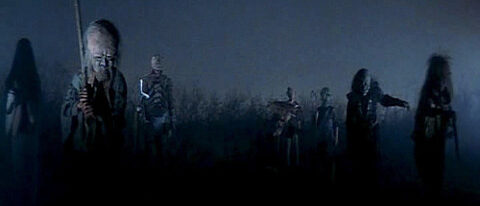
It turns into something of a road movie for a while, as her brave girl makes her way to her destination, sometimes with Mt. Fuji right by though of course it’s possible that these shots were manipulated and the cast weren’t near Mt. Fuji at all. She encounters a slightly older boy who helps her out in at least two moments of danger and also Hyakotaro. His introductory scene is odd; he sees the face of a ghost, hears a voice calling his name, then sees blood dripping in his glass of water. I assume that what’s basically happening is that the yokai are getting him to be on the side of good without him necessarily knowing it. Several things happen in these films that we don’t understand, but of course that can be good as well as bad. I like the idea that good people shouldn’t fear the yokai but can still see them. Anyway, encounters with villainous samurai keep coming along and there’s one pretty tense moment where Miyo is hiding in a waterfall, though plotting falters slightly when she keeps getting kidnapped. On the first occasion Sakaiichi grabs her and carries her on his back into the forest instead of somewhere more sensible; first of all she’s really heavy, then she sees a double of Miyo before hearing a voice telling him to stop his bad ways. Will he? We’re not sure. Miyo eventually finds her father, and it’s quite the surprise, leading to some quite emotional moments. Perhaps the most powerful scene is when she has to throw the dice her grandfather gave her three times to save her beaten-up father’s life; we know by now the origin of these dice but will they save him? There’s a lot of genuine human fear here, so much so that it almost makes the yokai scenes a bit tame by comparison.
I say almost, because there’s one nighttime tremendous set piece that is genuinely creepy, as two of our bad samurai are tormented by twig arms and hands before coming out on to a field where there are loads of statues, looking really eerie. One of the samurai asks permission of one of the statues to proceed, but in the next shot it’s a huge hairy thing [though the only genuine monster that we see], then we cut to all the statues moving, but from a distance so we can only slightly make them out. This one was co-directed by both Yoshiyuki Kuroda and Kimiyoshi Yasuda who helmed the first two films, so it’s perhaps of little surprise that these veterans of Zatoichi films made something that was rather similar, but here they show a knack of horror and one wishes that they’d gone even further down this route. The climactic scenes are a bit disappointing even though we see some flying heads, looking quite convincing too, while the white, ugly ghosts do look a little bit frightening in a few shots. These shots reminded me of one particular shot in another film but I couldn’t work out what it was until it came to me just five minutes ago as I was busy typing. Long time readers will know that I’m a huge Godzilla fan, and there’s a scene in Godzilla Vs Hedorah where several elderly-looking people who are a bit white like ghosts are watching the very very stupid young people of Tokyo having a big outdoor party despite this smog monster that’s on the rampage. Did director Yoshimitsu Banno see Along With Ghosts and was thinking of it when he made his highly eccentric entry in Toho’s endless franchise, or was this just coincidence? This is currently occupying my mind more than the thing that ought to be occupying it; the fact that, in Japan, ghosts are a form of yokai. I guess that I hadn’t yet picked that up.
There’s one out of place humorous scene where some samurai make fun of a very short waitress who they initially think is Miyo. She loses her temper and runs straight outside to crash into some pottery. Even though anyone unsettled by this in these PC times may be placated by the way she then gives these idiots what for and we’re clearly intended to be on her side, its inclusion is quite strange. Still, our two directors keep the pace going even when hampered a little bit by a script by the returning Tetsuro Yoshisa which requires lots and lots of chasing around the forest. That’s not great when we’re seeing the same fake scenery over and over again. Was the budget lower than the previous two? I know that the Japanese film industry wasn’t in a great shape at the time, with even the mighty Godzilla struggling to compete with TV and an economy in bad shape. But the performances are quite strong. Masami Burokido was obviously told to act extremely stoic like many children in Japanese movies, but has a purity of presence and is allowed some moments of emotion, while Mutsohiro [that’s the only name he seemed to have] does very well indeed as Miyo’s father; we know he’s a total louse yet sense some decency in him. Gamera veteran Kojiro Hongo does his usual solid hero act. Watanabe’s score doesn’t do more than repeat his main piece and add a slightly Italian-flavoured theme mostly used for the traveling sequence, but there’s greater use of sound effects than before, a couple of which may jolt if you have the sound up loud. In some ways highly disappointing but in others quite successful in its own right in achieving what it obviously set out to do, Along With Ghosts definitely has its pleasures and its strengths which for me go some way to make up for what many will see as its major flaw – little yokai – I feel that it will be the most controversial entry among viewers. It still ends, though, in the same great fashion as the first two.
Rating: 









SPECIAL FEATURES
Brand new 4K restoration of Spook Warfare by Kadokawa Pictures
Due to the fact that the other two ’60s yokai films are only given 2k restorations, Spooky Warfare unsurprisingly looks the best out of the three. The colours are strong, the many black or dark scenes are clear, and the grain is well managed and the right level. I only noticed a few extremely minor instances of print damage which shouldn’t bother anyone.
Original uncompressed Japanese mono audio for both films
Theatrical trailers for both films
US re-release trailers for both films
Image galleries for both films
DISC THREE – THE GREAT YOKAI WAR [2005] AKA YOKAI DAISENSO
RUNNING TIME: 124 mins
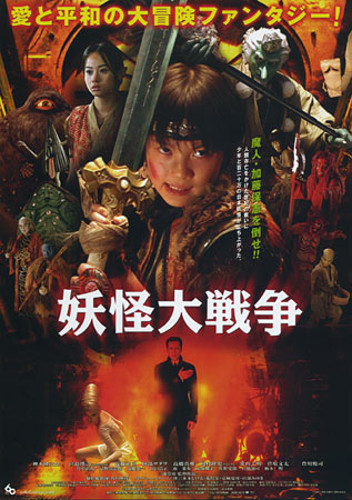
Tadashi, the son of recent divorcées, moves from Tokyo to a seaside village to live with his mother and grandfather. Lacking confidence. he finds it difficult to adapt to his new life and his heavy-drinking mother and dementia-suffering grandfather don’t make it any easier. However, at a local festival where a person is chosen every year to be the Kirin Rider, protector of all things good, Tadashi is selected, and is therefore destined to obtain the magic sword Daitenguken, from the Great Tengu, and protect the yokai from the advances of the evil Lord Kato and Agi who’ve just summoned Yomotsumono, a massive factory-like yokai born from all the things that humans throw away. Lord Kato and Agi have also found a way to transform yokai into mechanical demons. Accompanied by a small group of companions, Tadashi undertakes the quest to defeat Lord Kato and rescue Sunekosuri [and Tokyo] before it’s too late….

So finally we come to Takashi Miike’s reboot to which he’s not long made a sequel, Yokai Monsters: Guardians. It was made at a point in his career when he was slowing down the rate he was churning out films, toning down the extreme content and aiming more for the box office, though there would still be plenty of oddness. I did wonder if the Miike approach would remove some of the charm of the earlier yokai films, but in a way that fear isn’t hugely relevant because this one, even though it vaguely remakes Spook Warfare, is so very different to the ’60s works. Though inspired by Mizuki’s GeGeGe no Kitaro manga series which itself was based on a Japanese fairytale named Momotari, it uses the oft-told premise of the young boy who goes on a quest to save the world; familiar beats from some American fantasy pictures are present, but few American fantasy pictures are much like this one with its full-on anime-style imagery and that thrilling feeling which get from a lot of Miike that anything can happen. Inventive action, plain insanity and tributes and referenes to Mizuki mix with surprisingly deep themes and an aching sadness that fully blooms in the moving finale; this may surprise some though I often feel that there’s a heart to Miike’s work anyway. While there’s probably less blood than in the other yokai films, the fact that this appears to be intended for children might be laughable to some of us westerners with its intensity, brutality, dark humour, weird sexuality [not at all explicit but still] and heartbreaking ending, but there was once a time when something like, say, Old Yeller was considered a family favourite.
A grim opening shows us a destroyed Tokyo, tinged red by the setting son, and a small boy crying “Is anyone here; dad, sister, don’t go”. It’s actually only a dream by our youthful hero, but it casts a dark pall for some time. Then a demoness named Agi with a beehive comes dangerously to showing us part of her bum through a gap in her mini skirt, followed by the birth of a goo-covered, flayed, talking cow foetus. Yep, this is a kid’s movie remember. We’re introduced to our main villain, a suited fellow named Yasunori Kato who’s actually taken from a novel called Teito Monogatari by Aramata Hiroshi, summoning a fiery spirit called Yomotsumono in one of several scenes that were perhaps too ambitious for the budget, the CGI not being quite there, though that’s a feature of a lot of Miike. Kato now lives inside Yomotsumono which has become a huge factory-like complex where exists a pit above some flames into which Kato throws yokai who come out as kikai, machine monsters who are slaves to Kato and Agi who’s in love with Kato. Meanwhile Tadashi’s sad but dull [apart from some bullying] life, which brings in a favourite Miike theme of damaged family, is changed when he’s chosen to be new Kirin Rider, a title which is quite literal. A cute furry little yokai called a sunekosuri escapes from Yomotsumono to befriend while he tries to get this Daitenguken sword from The Great Goblin Mountain. All this probably sounds quite hectic, but much of the first half is fairly leisurely, investing us in Tadashi’s home life, his bonding with the sunekosuri and the building up of the stakes.
An early scene of Tadashi on a bus seeing loads of yokai peering in the windows and then in a forest recall the creepy moments in the earlier films; the latter is the only bit which attempts the feel of the earlier films. The real nasties are these hideous kikai made from scrap metal, unholy crosses between Terminator exo-skeletons, Transformers and Tetsuo The Iron Man, which the yokai have to do battle with, beginning with a load of sunekosuri surprised by a robot coffin with teeth. Tadashi is usually acccompanied by three yokai; Shojo a red yokai who has some of his hair stand up when danger nears, a cappa named Kawataro, and Kawahime, a female spirit who once saved a yokai-obsessed reporter named Sata from drowning when he was a child. The young Sata woke up between her legs, his hand stroking her leg, a shot repeated later on in a scene involving Tadashi. Was Miike was trying to sneak in as much child friendly pervy stuff as he could? Ther are also shots that linger on faces as they melt are a bit extreme for kids in a different way. The fighting hots up in sequences that are fairly well choreographed, and we’re eventually treated to the spectacle of thousands of yokai massing. It’s nice to see old favourites like the cappa [here much more human-like and rather obnoxious], the rokurokubi, who here not just has a neck that becomes ultra-long and twists all over the place but who actually licks Tadashi all over his face, the kaso-oneki, the faceless people and that huge face return. Then there’s also the azuki-arai who washes azuki beans; that’s actually all he does. And Yomotsumono, who eventually takes the form of a huge flying beast with a building on his head and factories on his back and flies around, is mistaken for Gamera, and even gets in a little bit of building smashing.
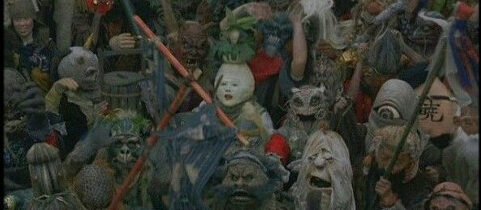
One destructive image towards the end is striking despite the CGI again falling short; we’re being asked to think of the atomic bomb, which also brings the film thematically to the likes of the first Godzilla. In fact amongst all the mayhem and plugs for Kirin Ichiban beer which even makes one adult character able to see the yokai – in this film only children can otherwise see them – we’re asked to think a bit. Despite all the fighting there’s an anti-violence message that comes to the fore to the end, with victory achieved in a very strange and non-violent way and important final lines from no less than Mizuki himself as the Great Elder Yokai. The main theme is how quickly we discard things, One of these being rubbish. We’re continuously chucking out stuff, and this film presents the idea that every single one of these things has a soul and is therefore enraged at being tossed aside. The holocaust that Kato is attempting to perpetuate would have probably happened; Kato is just speeding things up. He’s one of those villains who’s mad, but who also has a point. Indeed moral ambiguity is in several places, such as the character of Ippondatara, a blacksmith who ought to be able to fix Tadashi’s sword when it’s broken, but can’t because he’s imprisoned inside Yomotsumono. He does eventually escape, but only because the Sunekosuri takes his place. We’ve grown to love the sunekosuri yet can relate to Ippondatara, who’s tormented by what he’s done, for wanting to survive. The adult Sata is still madly in love with her, causing Tadashi to tell his first lie, though a lie told for good purposes. It’s suggested that the first lie is the first sign of adulthood, the first step in the losing of innocence, something which there’s no going back to.
Ryunosuke Kamiki is very emotive as Tadashi and is good at striking all the right cool poses after he’s suited up; this happens during a montage which alternates said suiting up with different yokai all over Japan about to go to a festival. Amusingly the festival turns out to be something rather different but none of the yokai [one and a half million or twenty million depending on who you believe] seem to realise. Koki Endo’s musical score, while containing several themes, had little power and imagination, while this yokai film does noticeably lack something that all the previous ones had; atmosphere, except for that forest sequence. The Great Yokai War will probably be never considered as one of Miike’s top projects, but it’s a most fun one and I still enjoyed it immensely despite it containing a great deal of something I find to be very ugly; poor CGI. He took a premise used in three older films but made something that’s very different, added more spectacle and employed modern technology, yet also added some depth and things to ponder upon. The theme of consumerism is even carried over into the special effects, with the yokai being achieved by traditional methods [except for the rokurokubi’s neck] while their opponents the kikai are CG. The most poignant theme is how we grow away from nature and imagination as we get older; even Kato says “those who discard their past have no future”. I really wanted to see what Miike’s version of the endings of the ’60s films would be like, but instead he did something different and maybe even better. His own final scene of the ghost of a creature unable to be seen by the adult he once knew is as a child is touching beyond words, and even a cheap final jolt which initially seems like a set-up for a sequel works, because we’re being given another important message; fanciful stuff may be gone to us adults, but evil remains alive and well in this world.
Rating: 









SPECIAL FEATURES
DTS-HD MA 5.1 original Japanese and dubbed English audio
Brand new audio commentary by Japanese cinema expert Tom Mes
Mes, who’s written two books about Miike, is obviously a good choice here. Even though his calm manner and relaxing voice may not be lively enough for some, Mes offers a fine mixture of appreciation and information. He spends some time talking about yokai, but also discusses certain scenes while they play, tells us things like Kato being inspired by a real wizard and Miike being happy when kids were scared by the film, and reminds us that family is really the prevalent theme of Japanese cinema. There are a few longish gaps and Mes signs off before he gets to comment on that touching final scene, but overall this is a good, if not great, track.
Interviews with the Cast:
Hroyuki Miyasako as Sada [5 mins]
The remaining special features, which run to around three hours, are taken from the Japanese Blu-ray by Kadokawa Films and seem to date from just before the film came out, dominated by this extensive selection of interviews which are intercut with interesting production footage. Sada says that he can relate to his character who doesn’t want to grow up, that he had lots of sand poured all over him three times, and that he wasn’t told of the wirework he had to do until just before it.
Masaomi Kondo as Shoujou [6 mins]
Kondo says that he loves yokai, that Shoujou is actually Chinese, and that the plane scene, which we see being shot, seemed ridiculous at the time.
Sadao Abe as Kawataro [6 mins]
Abe says that Miike didn’t tell him how to act scenes and that he watched loads of films during the lengthy time he has his makeup applied, after which we see him being presented with flowers – and a cucumber – on set.
Mai Takahashi as Kawahime [6 mins]
Takahashi says that she was nervous both performing with lots of experienced actors and surrounded by lots of blue, cries when she receives her flowers and encourages children to play outside.
Takashi Okaura as Azuki-arai [6 mins]
Okaura says that he thinks he overacted, that he often slept for three hours during makeup sessions, and moans that he couldn’t light or hold a cigarette in his costume.
Bunta Sugawara as Shuntaro Ino [4 mins]
Bunta, who played Takashi’s grandfather, doesn’t seem to know what to make of all the CGI and wonders how the film will turn out. He also says that he didn’t know what to make of the Mizuki museum when he visited, and that he wanted to play a yokai but ended up playing a human his own age.
Chiaki Kuriyama as Agi [6 mins]
Kuriyama says that she doesn’t feel that the film is a kid’s movie, that she tried on various costumes and when jokingly asking if she could use them all Miike agreed, and that she didn’t know if she would get through playing her character’s final scene.
Kiyoshiro Imawano as Nurarihyon [3 mins] – watch and complete these four tomorrow
Imawano, who played the yokai with an elongated back of his head, isn’t interviewed, but we do see him having his makeup put on and, as with every actor on here, performing a scene.
Etsushi Toyokawa as Yasunori Kato [4 mins]
Tohokawa sways that he was honoured to play a character he loved from the novel which he read as a kid, how he wanted to work with Miike for ages, and that we should buy the DVD because we’ll “want to see it over and over again and find new things every time”.
Interviews with the Crew:
director Takashi Miike [12 mins]
Miike says how he never got bored in the year and a half it took to make this film, that it was shot in sequence which aided Kamiki immensely, and that if he does have a style it’s unconscious. I tend to feel that Miike is slightly guarded in his interviews, and this is no exception.
Yokai designer Junya Inoue [5 mins]
Inoue says how the yokai and how they look had been decided upon until Miike was hired who changed some of them, describes a few, and that he was told to make Kawahime sexy which may have embarassed her.
Yokai design and molding Tomo Hyakutake [4 mins]
In his workshop, Hyakutake describes how he sculpted the yokai, that he was going to use CG for the bottom half of Ippon-datara but decided upon a suit, and shows lots of his drawings .
Yokai special make-up artist Yuichi Matsui [4 mins]
Matsui describes how the masks were made, says that the practical and CG departments helped each other out equally, and doesn’t think that such traditional methods will ever be totally supplanted by CGI,
art director Hisashi Sasaki [4 mins]
Sasaki says that he wanted the forest set to look like the ones in the older films, and describes and shows details of the other two main sets; the family house and insdie Yomotsumono. I thought far more of the latter was CG than it actually was, which is good I guess.
Yokai designers Yasushi Nirasawa & Takayuki Takeya [3 mins]
These two, one who did the yokai and one the kikai, interview each other, bringing up that the yokai were meant to look deformed and ill as they represented the decline of nature, while some of the kikai were like humans and some were just reckless machines.
CGI director Kaori Otagaki [6 mins]
Otagaki says how she told the cast and crew what to do when filming scenes where CGI was to be inserted, that getting the rokurokubi‘s neck movements was very hard, and that the sunekosuri was sometimes a puppet! Now that’s something I couldn’t tell this first time I watched the film.
Short Drama of Yokai, two shorts detailing the further adventures of the yokai
Introduced by the text WARNING, THIS IS NOT A SERIOUS PROJECT, these are amusing if inconsequential comic shorts about yokai returning from the battle, with morals for kids.
Episode 1: “Whose Hotcakes Are These?” [6 mins]
Four ogres fight over a bun which spends most of its time on the ground.
Episode 2: “Who’s the Most Annoying?” [7 mins]
My answer would normally be Kawataro, but here it’s another yokai who irritates other passing yokai with an exagurrated tale about catching a huge fish.
Another Story of Kawataro, two shorts featuring the continuing story of the kappa character in the film
Part One [6 mins]
And here he is, being even more obnoxious than before as he moans and moans to two other yokai before and after his “first social event” where there are air hostesses [though we don’t see those].
Part Two [10 mins]
I did feel a bit sorry for him here though as he’s interrogated by two policeman, one of whom shines a light in his face. His revenge is neat.
World Yokai Conference, a publicity event where Miike speaks about the film [13 mins]
Though obviously heavily edited, this extra, featuring some of the cast and crew,is a delight if you liked the film. Tada says he became a yokai, Miike says that Miyuki Mayabe who plays Tadashi’s teacher hit Kamiki for real with her attendance register, and there’s a earthquake tremor! The only sour note is when somebody says that the extremely aged Mizuki “has been spending much time in the land of the dead” because he hasn’t got anything else to say. A bito out or order really.
Promotional Events, video of the press conference to announce the start and completion of filming, as well as the premiere in Tokyo
Announcement Event [7 mins]
Some cast and crew offer promotional sound bites while Mizuki tells of when he thinks he came across a yokai, though of course he couldn’t see it.
Press Conference [3 mins]
Similar, including Miike saying that he’s “turning over a new leaf”.
Premiere [6 mins]
Similar, but with people being asked what yokai they’d like to be with, and both Miike and old man being a bit lustful over Kawahime;this is understandable to my eyes but maybe not too pleasant for her.
Documentary on the film’s young star, Ryunosuki Kamiki, and his experience making the film [27 mins]
After being blessed at a shrine, we follow Kamiki around the sets and shooting certain scenes. He was see him getting used to the puppet sunekosuri, looking scared on a construction atop a lake set and on wires, and fighting nothing, before clips from yet another conference. Kamiki frequently seems a bit overwhelmed. Lots more great behind the scenes stuff here though.
Theatrical trailer
Image gallery
LIMITED EDITION BOXSET CONTENTS
High Definition (1080p) Blu-ray presentations of all four films
As mentioned before, Spook Warfare looks very good, though unsurprisingly The Great Yokai War has the best picture, with seemingly no damage at all and loads of detail which can’t help but show up the flaws of the CGI a bit while the models and puppets probably look the same as they’ve always done. 100 Monsters is just as good as Spook Warfare in terms of colour despite being in 2k, though some lines can be seen and the soundtrack sounds just slightly off, like it was in bad shape and they couldn’t totally restore it. Along With Ghosts flickers a bit here and there due to specks and uneven grain; pictorially it’s the weakest though the sound is fine.
Optional English subtitles on all four films
Illustrated 60-page collectors’ book featuring new writing on the series by Stuart Galbraith IV, Raffael Coronelli and Jolyon Yates
Reversible sleeves featuring original and newly commissioned artwork by Jolyon Yates
Postcards featuring newly commissioned artwork for each film by Jolyon Yates
Foldout ‘yokai guide’ poster illustrated by Jolyon Yates
It’s a little disappointing that the three ’60s films don’t have much in the way of special features; I wanted to know more about them. All six movies on the Sam Katzman set had commentaries and documentaries. Still, the packed disc for Miike’s reboot makes up for this, and these are unique and intriguing films that should interest any lover of the offbeat. Kids will probably enjoy them too if they can get past the subtitles [though ‘The Great Yokai War’ has an English dub] and are the kind who don’t mind a few scares. Highly Recommended.


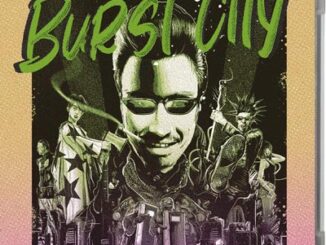
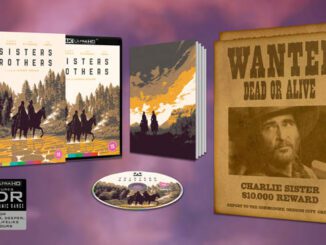
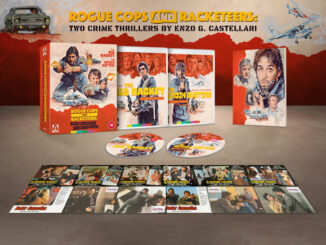
Be the first to comment